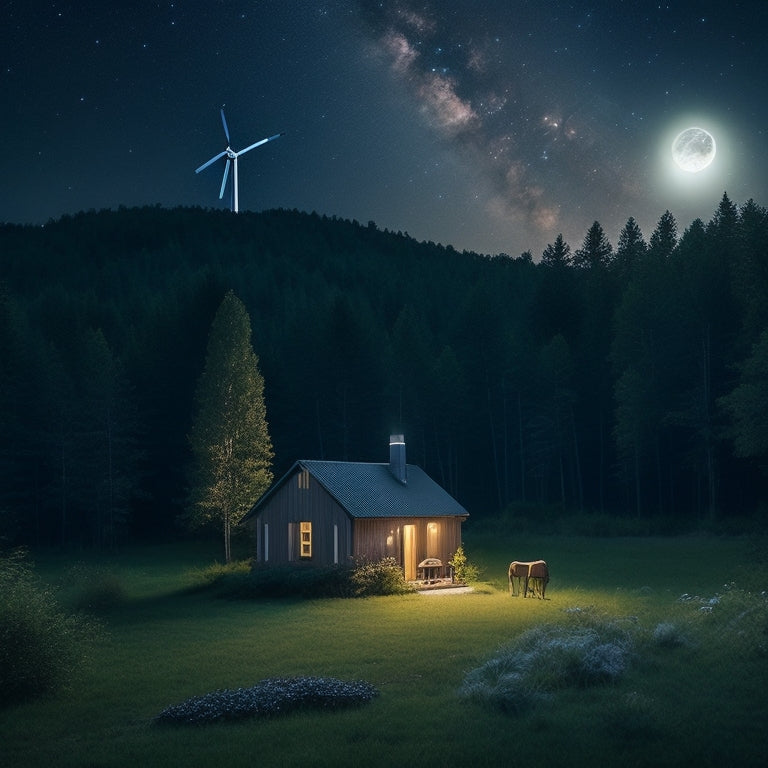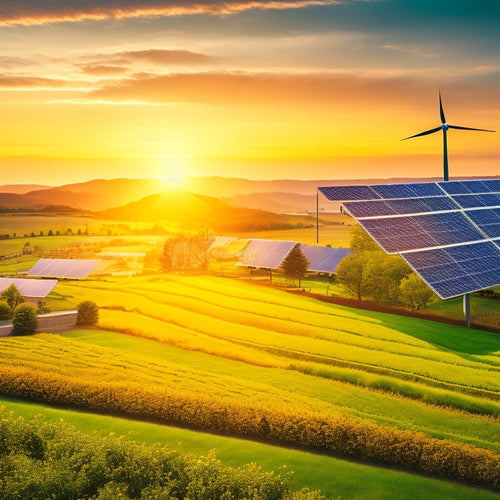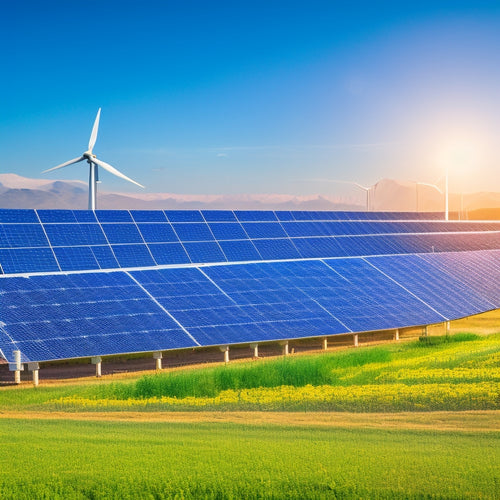
Essential Systems for Independent Homes and Cabins
Share
When designing an independent home or cabin, you'll need to prioritize essential systems that can provide reliable power, energy efficiency, and sustainable living. A well-planned solar panel system is key, integrating seamlessly with your off-grid lifestyle. You'll want to prioritize solar panel selection, system sizing, battery bank design, and inverter and charge controller compatibility. Proper mounting and installation, as well as regular monitoring and maintenance, are also vital. By understanding these essential systems, you'll be able to create a reliable and efficient energy solution tailored to your needs. As you explore the intricacies of off-grid living, you'll discover the finer details that bring it all together.
Key Takeaways
• A reliable off-grid solar power system requires careful selection of solar panels, charge controllers, inverters, and battery banks to ensure efficient energy harvesting and storage.
• Proper system sizing and load calculation are crucial to ensure a reliable power source, even on cloudy days, and to prevent system overload or underload.
• A well-designed battery bank is essential for balancing energy storage and battery life, and involves selecting the right battery type, number, configuration, voltage, and capacity.
• High-efficiency inverters (above 95%) and compatible charge controllers are necessary to prevent system malfunctions and optimize energy harvesting, while also enabling advanced features like MPPT and system monitoring.
• Regular monitoring and maintenance are vital to ensure the system operates efficiently, including checking water levels, inspecting for pests, performing routine cleaning, and scheduling regular maintenance tasks.
Solar Panel System Components
You'll need several key components to build a complete solar panel system, including solar panels, a charge controller, an inverter, and a battery bank. These components work together to convert sunlight into usable electricity, ensuring energy efficiency and a reliable power supply.
The solar panels convert sunlight into DC power, which is then regulated by the charge controller to prevent overcharging or undercharging of the battery bank. The inverter converts the DC power into AC power, making it compatible with your home's electrical system.
With a grid connection, you can feed excess energy back into the grid and offset your energy consumption, maximizing your energy efficiency. This setup allows you to tap into the grid when needed, ensuring a stable and efficient energy supply.
Off-Grid Solar Power Systems
When designing an off-grid solar power system for your independent home or cabin, you'll need to meticulously choose the right solar panels for your specific needs.
You'll also need to take into account system sizing, factoring in aspects such as your energy usage, battery capacity, and the local climate.
Solar Panel Selection
Selecting the right solar panels for your off-grid solar power system requires careful evaluation of several key factors, including panel efficiency, durability, and compatibility with your system's components. You'll want to assess the panel's efficiency rating, which measures how well it converts sunlight into electricity. Look for panels with high efficiency ratings (above 20%) for best performance.
Another essential factor is the warranty offered by the manufacturer. A thorough warranty can provide peace of mind and protect your investment. Be sure to review the warranty terms, including the duration, coverage, and maintenance requirements.
Here's a comparison of popular solar panels for off-grid systems:
| Panel Model | Efficiency Rating | Warranty |
|---|---|---|
| Panasonic HIT-240 | 21.8% | 25-year performance, 10-year product |
| LG Solar NeON 2 | 20.5% | 25-year performance, 10-year product |
| Trina Solar TALLMAX | 20.3% | 25-year performance, 10-year product |
| Hanwha Q CELLS Q.PEAK | 20.2% | 25-year performance, 10-year product |
| Jinko Solar Eagle | 20.1% | 25-year performance, 10-year product |
When choosing solar panels, take into account your system's specific needs and priorities. By weighing these factors, you can select the right panels for your off-grid solar power system.
System Sizing Considerations
Sizing your off-grid solar power system correctly is vital to guarantee it meets your energy needs, and a thorough assessment of your energy requirements is the first step in this process. To do this, you'll need to perform a load calculation, which involves identifying the total wattage of all your appliances and devices. This calculation will help you determine the total power requirement of your system.
When conducting your load calculation, consider energy efficiency measures such as LED lighting and Energy Star-rated appliances, which can greatly reduce your energy needs. You should also consider the type and number of batteries you'll need, as well as the capacity of your charge controller and inverter.
A well-sized system ensures you'll have a reliable source of power, even on cloudy days or during periods of high energy usage.
It's important to get this right, as an undersized system can lead to frequent battery depletion, while an oversized system can be a costly waste of resources. By taking the time to accurately assess your energy needs, you'll be able to design a system that meets your unique requirements, providing you with the independence and reliability you need to thrive off the grid.
Battery Bank Design Considerations
Designing an efficient battery bank requires thoughtful deliberation of several key factors, including the type and number of batteries, their configuration, and the overall system's voltage and capacity. When selecting batteries, you'll need to take into account the depth of discharge (DOD), which impacts the battery's overall lifespan. A higher DOD means more energy is extracted from the battery, reducing its cycle life expectancy. You'll need to strike a balance between maximizing energy storage and preserving battery life.
You'll also need to decide on the battery configuration, whether it's a series, parallel, or series-parallel setup. This will influence the overall system voltage and capacity, which in turn affects the system's performance and reliability. A well-designed battery bank should provide the necessary power and energy storage while minimizing maintenance and replacement costs.
When designing your battery bank, take into consideration the application's specific requirements, such as the maximum power output, voltage, and capacity. By carefully selecting the right batteries and configuration, you can create a reliable and efficient energy storage system that meets your needs.
Inverter and Charge Controller
With your battery bank in place, you'll need a reliable inverter to convert the stored DC power into usable AC electricity for your independent home or cabin. A high-efficiency inverter is essential to minimize energy losses and maximize your system's overall performance. Look for an inverter with high inverter efficiency, typically above 95%, to make sure you're getting the most out of your stored energy.
When selecting an inverter, consider the compatibility of the charge controller, as it plays an important role in regulating the flow of energy between your solar panels, battery bank, and inverter. Confirm the charge controller is compatible with your inverter to prevent system malfunctions and optimize energy harvesting. A compatible controller will also enable advanced features like maximum power point tracking (MPPT) and automatic system monitoring.
Mounting and Installation Options
When designing your off-grid system, you'll need to decide on a mounting and installation option that suits your site's conditions and your energy needs.
You'll have to choose between roof-mounted solar systems, which can be ideal for cabins with limited land availability, and ground-based installations, which can be more flexible regarding panel orientation and system expansion.
Roof-Mounted Solar Systems
You'll typically choose from two primary mounting options for roof-mounted solar systems: asphalt shingle-compatible racks or standing-seam metal roof clamps, each designed to securely fasten your solar panels to your rooftop. These mounting options guarantee a secure and durable installation, allowing you to harness the power of the sun with confidence.
When selecting a mounting system, take into account roof angle considerations, as the ideal angle will vary depending on your location and the time of year. A properly angled roof-mounted system will maximize energy production, bringing you closer to energy independence.
For top energy production, it's crucial to contemplate the orientation and tilt of your solar panels. A south-facing roof with a tilt between 30-40 degrees is often ideal, but this may vary depending on your specific location and climate.
Ground-Based Installations
Ground-based solar installations offer an attractive alternative to roof-mounted systems, providing more flexibility with panel orientation and tilt, allowing you to optimize energy production based on your specific climate and location.
With ground-based installations, you can choose the perfect spot for your solar array, taking into account shading, wind direction, and snow load. You'll have more control over the system's design, ensuring maximum energy output.
When it comes to installation, you'll need to assess ground clearance, ensuring that the panels are high enough to avoid snow accumulation and debris. You'll also need to evaluate soil stability, as unstable soil can compromise the system's structural integrity.
A thorough site assessment will help you identify potential issues and determine the best anchoring system for your installation.
Ground-based installations often require more land, but they offer greater flexibility and can be designed to accommodate your specific energy needs. By choosing the right mounting and installation options, you can create a reliable and efficient solar energy system that meets your off-grid or independent living requirements.
Monitoring and Maintenance Tips
Regularly inspecting your off-grid systems and performing routine maintenance tasks can help prevent unexpected failures and prolong the lifespan of your equipment. By staying on top of maintenance, you'll reduce the risk of costly repairs and guarantee your systems continue to function efficiently.
Here are some essential monitoring and maintenance tips to keep in mind:
-
Check water levels and quality: Regularly test your water quality and monitor tank levels to prevent contamination and maintain a steady supply.
-
Inspect for pests: Regularly examine your systems for signs of pest infestation, which can damage equipment and compromise water quality.
-
Perform routine cleaning: Clean your systems regularly to prevent sediment buildup and maintain peak performance.
- Schedule regular maintenance: Set a schedule for routine maintenance tasks, such as filter replacements and system checks, to ensure your systems continue to operate efficiently.
Frequently Asked Questions
Can I Install an Off-Grid System on an Existing Cabin or Home?
You can retrofit an off-grid system into your existing cabin or home, but be prepared to tackle retrofitting challenges, such as integrating new systems with existing infrastructure, to achieve peak energy efficiency.
Are There Any Incentives for Installing Off-Grid Solar Power Systems?
"Ha! You think the government's just gonna hand out free money for going off-grid? Think again! But, yes, you can snag some sweet Tax Credits and Government Grants to offset the cost of that shiny new solar panel system you're eyeing."
How Do I Determine the Size of the Solar Panel System I Need?
To determine the size of your solar panel system, you'll need to perform a load calculation, evaluating your energy efficiency and daily energy usage, then consider factors like panel wattage and local solar irradiance.
Can I Add a Wind Turbine to My Off-Grid Solar Power System?
Imagine a remote village in Scotland, where a resident, Sarah, powers her cabin with solar panels and a wind turbine, storing excess energy in a battery bank for rainy days, ensuring a reliable off-grid system.
Do I Need a Backup Generator With an Off-Grid Solar Power System?
You'll want a backup generator with your off-grid solar power system to guarantee power during outages, as grid reliability can be unpredictable, providing a reliable source of energy when the sun isn't shining.
Related Posts
-

Net Metering in Renewable Energy's Future
Net metering's future is vital for driving renewable energy growth and financial savings. You can reduce your electri...
-

The Role of Battery Monitoring Systems in Renewable Energy
Battery monitoring systems play an essential role in renewable energy by enhancing system longevity and optimizing pe...
-
Average Lifespan of Solar Battery Banks
The average lifespan of solar battery banks generally ranges from 5 to 15 years. This variation mainly stems from the...

